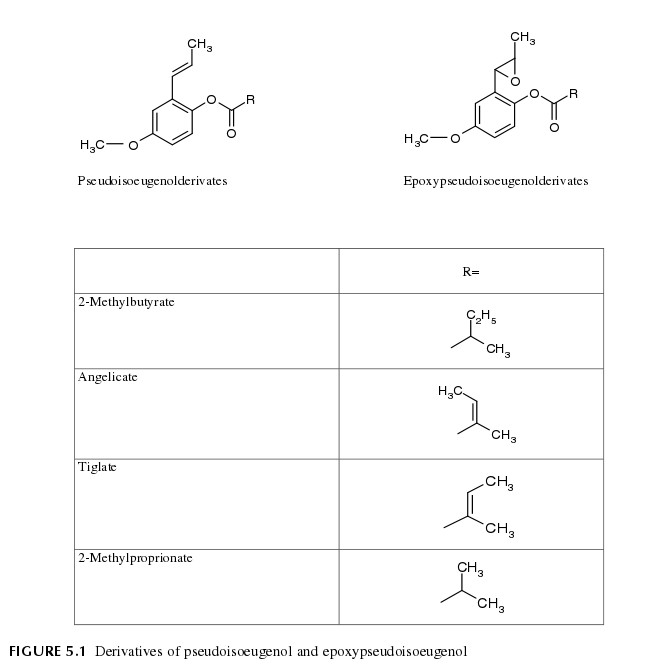Dies ist eine alte Version des Dokuments!
Pimpinella major (L.) Hudson- syn.Pimpinella magna L.; Pimpinella media Web.; Pimpinella angustifolia Gilib.; Pimpinella dumetorum Boenningh., Pimpinella saxifraga major L., Apium pimpinella Caruel, Carum magnum Baill. - Apiaceae
great burnet saxifrage, Große Bibernelle, Bibernell, Pimpernell, Bockskraut
Perennial herb, 0.40-1m high, native to Europe, naturalized in North America; leaves pinnate; flowers white to pink.
Main compound of root oil is trans-epoxypseudoisoeugenyl tiglate (19.5%), accompanied by structurally related minor constituents, such as pseudoisoeugenyl tiglate (3.4%), trans-pseudoisoeugenol 2-methylbutyrate (traces) and epoxypseudoisoeugenyl 2-methyl butyrate (traces). A number of sesqui- and tri-norsesquiterpenoids (C12-hydrocarbons) occur in appreciable amounts, like δ-elemene (12%), pregeijerene (9.7%), and germacrene-C (7.8%). Monoterpenoids could only be found in traces (p-cymene).
[The essential root oil of Pimpinella major., Bohn, I., Kubeczka, K. H., Schultze, W., Planta medica, Vol.55(5), 1989, 489-490]

pseudoisoeugenol derivatives have been found exclusively in the genus Pimpinella (from: elibrary.com.ng [PDF] 5 Chemical Constituents of the Genus Pimpinella
„Leaf/root-differentiating callus cultures grew without growth regulators in a modified MS liquid medium. The capacity of callus to accumulate rare phenylpropanoids such as epoxypseudoisoeugenol tiglate (EPT), epoxy-anol tiglate (EAT) and anol tiglate (AT) was compared with that of seedlings and whole plants. Unorganized callus cultures failed to accumulate any phenylpropanoids, whereas the leaf/root-differentiating callus culture accumulated EPT. Leaves and roots contained 360 and 1000 µg EPT/g FW, respectively. The distribution of phenylpropanoids in different organs of the whole plant showed that EPT could be found in various organs (roots, leaves, fruits, stems, flowers, pedicels and ovaries) in amounts ranging from 0 (in fruits) to 10.7 mg/g FW (in roots). EAT and AT were present in fruits at concentrations of 7.0 and 5.3 mg/g FW, respectively. In seedlings, EPT occurred at concentrations of 0.4-0.7, 0.8-1.0 and 0.5-0.6 mg/g FW in roots, cotyledons and leaves, respectively.“
[Comparative investigation on formation and accumulation of rare phenylpropanoids in plants and in vitro cultures of Pimpinella major., Merkel, B., Reichling, J., Zeitschrift für Naturforschung. Section C, Biosciences, Vol.45(6), 1990, 602-606]

